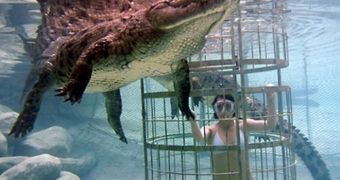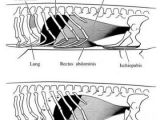What makes crocodiles and alligators so feared is not only their sheer power and enormous toothed jaws, but also the stealth of their attacks: there's no ripple warning the victim that the huge monster is approaching until the quick deadly dash. Researchers have been puzzled at the smoothness of their movement in the water, since they lack fins or flippers. The answer is given by a new research published in the Journal of Experimental Biology: special muscles change the position of their lungs.
The American alligators appeared to use their diaphragm, pelvic, abdominal and rib muscles for shifting their center of buoyancy, moving the lungs toward the tail when diving, and toward the head when they ascend to the surface, or sideways to roll.
"What this does is it gives the animal a way to change trajectory. It allows them to quietly change how they are positioned in the water so they can strike. This doesn't require any really quick movements that might give their position away," said co-author T.J. Uriona, a doctoral student at the University of Utah.
This newly discovered process of buoyancy control could be also employed by other aquatic vertebrates, like African clawed frogs, salamanders, turtles and manatees. Moreover, the study comes with a different explanation for the presence of diaphragm muscles in crocodilians, as other living reptiles are devoid of it. The ancestors of the crocodiles and alligators appeared 250 million years ago (during the Triassic period) and were cat-sized bipedal (running on two feet) land dwellers. Many scientists thought the diaphragm evolved for easing the breathing while the animal was running.
"Showing they are actually using it to move around in water gives an alternative explanation for why the muscle evolved. It may be that instead of these muscles arising for breathing, they arose for moving around in the water and later were co-opted for breathing," said Uriona.
The study points that the muscles didn't evolve until crocodilians adapted the aquatic life during the Cretaceous Period, 145 million years ago. Now the crocodilians also evolved a flattened skull, shorter limbs and a big tail.
The team made its study on 2-year-old American alligators from Louisiana's Rockefeller Wildlife Refuge near Grand Chenier. These young gators were just under 2 ft (60 cm) long, manageable for experiments. (imagine that an adult alligator can be 15 ft (5 m) long). Attached electrodes monitored the movement of their muscles and a digital device determined their trajectory into the water. The animals were placed in an aquarium the size of a small bathtub and observed while diving and rolling.
The respiratory muscles
It appeared that the reptiles pulled their lungs back for lifting the tail when diving, and moved them to the side for rolling, When going to the surface, the lungs were push forward. Three sets of muscles were involved in moving the lungs:
The diaphragmaticus, the breathing muscle like the diaphragm that splits the chest cavity from the abdominal cavity in mammals. But this is not the same with the diaphragm muscle in mammals and humans. In crocodilians, it runs parallel to the belly and wraps the stomach and intestines. When the crocodilian breathes, the diaphragmaticus pulls the liver back toward the pelvis and tail. The liver is attached to the lungs, so when the liver is moved back, it expands the lungs.
The ischiopubis muscles (a pair). Each ischiopubis muscle inserts to the ischium, a pubian bone. The pelvic bones of the pubes and ischia are not joined in crocodilians (like in humans and mammals) and the alligators can puff out their bellies, so that the liver is moved towards the tail, followed by the subsequent lung inflation.
The rectus abdominis muscles, corresponding the human abdominals. In crocodilians, these muscles encase the belly ribs, pushing the intestines upward to expel air from the lungs during exhaling.
"The diaphragmaticus likely began as part of the rectus abdominis muscle and evolved into a separate muscle," said Uriona.
First, the diaphragmaticus' insertion to the breastbone was replaced by one to the liver. Second, separate nerve connections went to the diaphragmaticus and abdominals, as one is used to inhale and the other to exhale.

 14 DAY TRIAL //
14 DAY TRIAL // 
